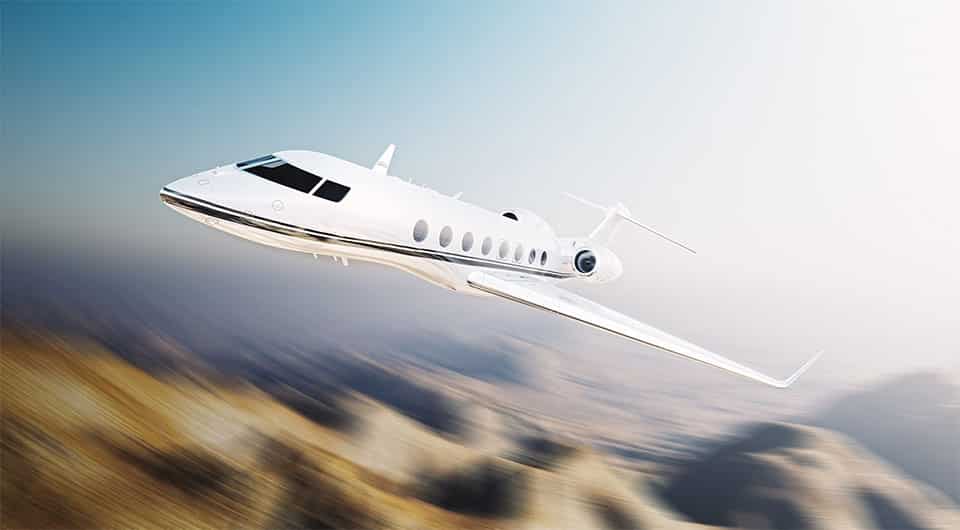Air Travel: The Luxury of Speed

When airlines entered the travel market in the 1920s with a revolutionary way to move about the country, their major selling point was speed. Until then, the fastest way to get from New York City to Los Angeles was by train. It took at least 5-days to travel from coast to coast via rail. The first airlines reduced that travel time to 3-days by using a combination of daytime flights and overnight rail service.
The fare for that coast-to-coast trip from New York City to Los Angeles was $350 in the 1920s. To put that into perspective, a new car then cost about the same. Taking advantage of the speed of air travel came at a “luxury” price. A significant number of the most-successful businesspeople in the country were willing to purchase the luxury of speed—primarily as a strategy to beat their competition and increase their productivity.
As more and more businesspeople, celebrities and other high-profile Americans indulged their “need for speed”, the number of airline passengers increased at an impressive rate. Within a few short years, the roots of modern air travel were firmly established in the burgeoning American travel market. And this was before the days of airline “yield management” and highly discounted tickets. Clearly, the luxury of speed sells.
I must admit that I’ve been a “speed freak” my whole life. My earliest memories of the need for speed go all the way back to the 1950s when I was 6-years old. I lived under the arrival corridor to Chicago’s Midway airport. I can remember gawking at the prop airliners of the day zooming by overhead and dreaming about what it must be like to experience all that speed.
When I was 11-years old, I experienced the speed of air travel first-hand. I left the ground for the first time (my first flying lesson) and soared through the heavens in a small airplane at 120 mph. I was thrilled with the big upgrade in speed from the old man’s Chevy, but I dreamed about the much-faster air-travel experiences awaiting me in my planned career as a jet fighter pilot.
This fascination with speed stayed with me over my fifty-plus years of air travel—both as a pilot and passenger. But, I learned early on that the faster you want to travel, the more it costs. And, these costs are usually on a level that puts rapid travel in the “luxury” category.
When I started flying for United Airlines in 1968, I began to appreciate that it’s the door-to-door travel time that defines the overall speed of travel. Even back then, we could speed through the air at almost 600 mph, but the ground time from when you left home to when you were airborne could easily exceed the time you were in the air. And, of course, you must also account for the travel time from landing to getting to where you want to go at your destination.
For example, the typical flight time for an airliner from Chicago to New York City is around 1.6-hours. Chicago-area business travelers must depart from O’Hare or Midway Airports. Most of them allow for a one-hour drive time to the ORD parking lot. It can then take at least half an hour to get to the departure gate, and the TSA recommends (for good reason) arriving at the airport at least two hours before the “scheduled” departure time. Then, it usually takes at least half an hour to get on the airplane, taxi out and takeoff.
That’s a grand total of four hours (including waiting time) from leaving home to takeoff. It can easily take over one and a half hours from the time you land in New York to when you arrive at your destination. So, in this example your door-to-door travel time is more than seven hours. A similar door-to-door travel time applies to your return trip home. The result is a roundtrip door-to-door travel time of around 14-hours. That’s why it’s all but impossible to make a one-day business trip on the airlines anymore.
When you’re calculating your door-to-door travel time for a typical airline flight today, you must also consider the endemic flights delays. Since the early days of airline deregulation (1980s), annual airline domestic delay rates have hovered around 25% year-in-and-year-out. With around 100,000 U.S. domestic airline flights each day, that’s approximately 25,000 delayed flights every day.
Most of these delayed flights are part of a chain of “domino-effect” delays. A large portion of the U.S. domestic airline fleet spends the night in “out stations” (i.e., Dubuque, Springfield). There are usually no reserve crews or maintenance support in these out stations. If a crewmember gets sick or the airplane breaks, a delayed departure to the airline’s hub in the morning is inevitable.
With very-tightly-scheduled airline-hub operations and the fact that airlines typically fly their aircraft on five or six domestic flights every day, that original delayed flight can trigger four or five additional delays during that day. In my opinion, the adoption of a hub-and-spoke route system by virtually all the major airlines immediately following deregulation baked these domino delays into the operating system. For over 40-years now, no one has figured out a way to get around this problem. This makes the airline system highly unreliable for today’s business travelers.
The groundside infrastructure that supports airline operations (access roads, parking facilities, terminals, ramps, taxiways and runways) has also been a major cause of the increase in door-to-door travel times for the first time in human history. And there’s not much hope that this problem will be fixed. It takes almost 20-years for an airport to make an incremental expansion to its groundside infrastructure while airline traffic is doubling every 10-years.
Today’s airlines no longer offer the luxury of speed to business travelers. It takes too long to travel door-to-door to the major business destinations in the U.S. and the airline system is highly unreliable from a business traveler’s point of view. And, the indignities and frustrations associated with modern airline travel significantly degrade the “luxury of speed” experience.
But, what’s the alternative? For business travelers, car or bus travel takes way too long if the destination is more than 200 miles away. Train service is very limited and too slow for longer trips. Owning or chartering a business jet is the best solution, but the cost of such luxury is prohibitive for all but around 0.5% of business travelers. Are business travelers going to be locked into the productivity-killing travel experiences they’re enduring today on the airlines?
Fortunately, an alternative to airline travel is now making its debut. This innovation in air travel makes it possible for frequent business travelers to take advantage of the luxury of speed at a reasonable and justifiable price. This sensible alternative is the emerging segment of the business-jet market commonly knowns as “single-seat charter”.
U.S. Department of Transportation regulations now allow the sale of single seats on business-jet charters. This regulatory framework has spurred the establishment of air-travel companies like Jetsmarter, Wheels Up, XO, JetLinx and AirChicago. They all offer some form of single-seat charter on business jets. These new business models make it possible for frequent business travelers to purchase the luxury of speed at airline unrestricted business-class fares. For example, you can travel from Chicago to New York City on AirChicago for less than the $1,550 airline business-class fare.
And even better, they offer real luxury along with the speed. In our above example of a business trip from Chicago to New York city, the door-to-door travel time on the airlines is 7.1-hours each way. On a single-seat charter flight with AirChicago it’s only three hours each way. That means that a savvy business traveler can enjoy the luxury of speed to save almost eight hours of productive time. But wait, it gets even better than that. The roughly three hours spent on the airplane can also be added to proactive time because the cabins on business-jets are designed for business networking and working onboard.
Imagine this: You have a lunch meeting in Manhattan tomorrow. You call your favorite airline to make a reservation for the first flight to New York in the morning. You find that there is a business-class seat available departing from ORD. Because you’re making your reservation within 48-hours of departure, you’re going to have to pay the unrestricted, full-fare price for the ticket. This is no surprise to you since 85% of all business travel is booked within 48-hours of departure and the airlines usually don’t offer steeply discounted fares in this case.
You’re a savvy business traveler and you know that the first few airline flights to NYC are often delayed due to the late arrival of the aircraft and crew for the flight from an out station. So, you book a business-class seat on the first flight of the day to LaGuardia Airport. That flight is scheduled to depart ORD at 6 AM and arrive at LaGuardia at 9:15 AM Eastern. This plan gives you 3 backup flights that may possibly get you into NYC on time for your important lunch meeting.
This means that you’ll have to get up at 2:30 a.m. to arrive at the security check point only an hour before the scheduled departure time. You think this will probably work as long there are no major traffic or security glitches. This plan has at least two hours of potential waiting time built into it on the departure end if your flight is delayed or you miss it, and the same on the NYC end if you’re departure from ORD is not delayed.
If you are making a one-day business trip, you won’t get back home until well after dinner time if everything goes smoothly. You’re going to lose the cherished family time that you enjoy both in the morning and evening. And you’ll end up with at least four wasted hours of waiting time. Your productivity, decision-making capabilities and all-around alertness will be negatively impacted by fatigue. The frustration and intensity of your airline experience will also contribute to a higher stress level than is good for you.
Now, imagine that you’re a member of one of the new single-seat-charter programs. You book a single seat on one of the program’s members-only business jets that is scheduled to depart Chicago Executive Airport in Wheeling at 7:30 a.m. and arrive at Westchester County Airport in White Plains, NY at 10:15 a.m. Eastern. The cost of the flight is not a mystery. You know that it’s around the same price as the business-class ticket you had to purchase from the airlines.
The next morning, you get up at 6 a.m. because the drive to Chicago Executive Airport is only 30-minutes and you need to arrive at the private departure terminal only a few minutes before departure. As you go out the door at 6:45 a.m. you’re feeling really good because you got your regular night’s sleep, you got to give your spouse and kids a quick kiss and you know you’ll be home in time for dinner and some before-bedtime time with the kids. You are also not stressed by the possibility of traffic and security delays on the way to and at the airport.
You have an uneventfully short drive to the airport and park your car in a free parking space next to the hangar that houses the 14-seat, executive-cabin business jet you’re going to fly on to NYC. Since the jet was parked in the hangar overnight and your flight crew lives locally, you know that there is little chance of your departure being delayed.
It takes you less than five minutes to walk from your car, clear security and board your aircraft that is waiting for you in the hangar. As you take your seat at 7:15 a.m., the captain announces that all the members who booked a seat on the flight are onboard and you’ll be departing immediately—15-minues early! You’re off the ground at 7:25 a.m.
The flight is smooth. You enjoy a light breakfast while getting know the new members who are on the flight with you. After a short visit to the cockpit, you use the last half hour of the flight to review the presentation for the lunch meeting in Manhattan at noon. The business jet is parked in front of the private terminal at Westchester County Airport at 10 a.m. Eastern.
As you descend the airstairs from your members-only business jet, you notice that, as usual, a limo is waiting for you just a short walk from the airplane. The driver has already loaded your just-in-case overnight bag and you’re in the car and out of the airport just five-minutes later. You arrive in downtown Manhattan at 11:05 a.m. with enough time to take a short stroll before you meet your client for lunch. As you enjoy the sights, sounds and smells of the Big Apple, you reflect on the fact that you’re relaxed, alert, enthusiastic and ready to close the big deal you’re after.
Avoiding the uncertainties, hassles and frustrations of airline travel like you did in the above scenario may seem like a dream that’s too good to be true. But it’s becoming a reality with the several new single-seat-charter companies entering the market. However, there is one fly in the ointment. My calculations indicate that this revolutionary alternative to airline business travel will be available to less than 1% of the 50-million business travelers in the U.S.
This very small percentage of business travelers who will be able to enjoy the increased productivity and reduced stress of traveling on a members-only business jet is the result of the major constraints inherent in the business-jet-travel system. The primary constraints are the capacity of local business-aviation airports and the number of seats on executive cabin business jets. I calculate that around only 500,000 business travelers in the U.S. will be able to become members of a single-seat-charter business-jet program.
It appears that those memberships are going to become a rare find rather quickly as savvy business travelers discover this viable alternative to airline travel. The early adopters will capture the memberships and enjoy the benefits of introductory pricing and the opportunity to become more competitive and productive. I already have my business-jet-travel membership. I’m looking forward to seeing you on a flight soon.
Have you read?
Turkey Citizenship By Investment Program, Moldova Citizenship By Investment Program, Vanuatu Citizenship By Investment Program, St. Lucia CIP: Saint Lucia Citizenship By Investment Program, and The Montenegro Citizenship By Investment Program.
Bring the best of the CEOWORLD magazine's global journalism to audiences in the United States and around the world. - Add CEOWORLD magazine to your Google News feed.
Follow CEOWORLD magazine headlines on: Google News, LinkedIn, Twitter, and Facebook.
Copyright 2025 The CEOWORLD magazine. All rights reserved. This material (and any extract from it) must not be copied, redistributed or placed on any website, without CEOWORLD magazine' prior written consent. For media queries, please contact: info@ceoworld.biz








